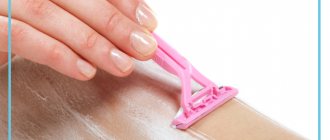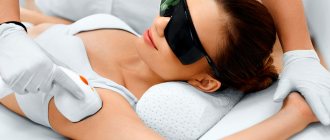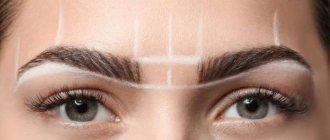The presence of unwanted hair is a problem for many people who are not satisfied with long-standing methods of hair removal (shaving, waxing and chemical depilation, electrolysis) due to either short-term results, severe pain, or frequent complications (for example, scarring after electrolysis). The invention of selective photothermolysis and the creation of various laser systems with different wavelength ranges have made effective and long-term hair removal possible. Currently, several types of laser and photosystems are used for hair removal: ruby laser (694 nm), alexandrite laser (755 nm), diode laser (800 nm), IPL systems (590-1200 nm), Nd:YAG laser ( 1064 nm).
Hair removal occurs due to the destruction of the hair follicle, where the main pigment is melanin, which acts as a chromophore - a substance that absorbs radiation with a certain wavelength. With optimal selection of wavelength, energy flux density and pulse duration, the melanin of the hair follicle heats up and the hair follicle is destroyed. The surrounding tissues are not damaged.
Compared to existing types of hair removal and depilation, laser hair removal destroys the hair follicle quickly, precisely and precisely, which explains its high aesthetic result. In addition, hair removal using lasers and photosystems allows you to quickly, practically painlessly and with minimal risk of complications treat large surfaces of the skin. It is no coincidence that it has become one of the most popular among all aesthetic procedures performed using quantum technologies. Laser and IPL systems, according to manufacturers, help quickly, safely and effectively remove unwanted hair. But numerous studies show that these methods of hair removal are still not without side effects and complications.
Due to the growing popularity of laser hair removal, laser therapists, dermatologists, cosmetologists, and general practitioners must know the possible complications and side effects of these procedures in order to diagnose and treat them correctly and in a timely manner.
Causes of complications
Let us list the main reasons for the development of complications characteristic of all types of procedures using lasers and IPL systems.
- Professional errors of a doctor, which include poor quality training; diagnostic errors, especially in determining the phototype and skin condition; incorrect choice of laser type and its radiation parameters; failure to carry out test exposure; imperfection of laser technology; incomplete patient awareness of the procedure, its results and post-procedure care; lack of eye protection for the patient or doctor; lack of adequate cooling of the skin during the procedure.
- Failure of patients to comply with doctor’s recommendations for post-procedure care.
- The patient's health condition during the procedure. This factor affects the effectiveness of the procedure itself and the development of complications in the post-procedure period. Even with a high-quality history collection, we cannot fully take into account the presence of all aggravating factors and diseases in the patient, since he does not always know about them.
When collecting anamnesis, it is important to take into account the patient’s tendency to allergic reactions, the presence of hormonal disorders, immunodeficiency conditions, connective tissue diseases and tumor diseases, and the patient’s taking medications that affect the functional activity of melanocytes.
Why Alexandrite laser?
The main competitor of the alexandrite laser is the diode laser. Knowing all the pros and cons of both types of installations, we chose the latest generation alexandrite .
Among the many advantages of the CANDELA device, the main ones include:
- The laser wavelength is 755 nm - this is the most optimal value for the hair melanin to absorb the radiation. Diodes have a longer wavelength. But the energy is less. Ours is cooler!
- Effective for dark (1-3 phototypes) and light hair on light skin (1-2 phototypes). Laser hair removal with ANY LASER is ineffective for gray and completely white hair that lacks melanin.
- Pain sensations with diode lasers are more acute (according to reviews from our patients).
When you sign up for your first test procedure, you receive a 15% discount! We also have a number of special programs with discounts!
Side effects of laser hair removal
Now let's move on to the side effects of laser and IPL hair removal procedures and their complications. Side effects of laser hair removal include pain, perifollicular swelling and erythema of the skin of the treated area. Perifollicular edema and erythema occur within a few minutes after exposure, resolve within a few hours and do not require treatment.
The severity of these reactions depends on the color, thickness and thickness of the hair, as well as on the density of the energy flow. Dark, thick hair absorbs a lot of energy during the procedure and becomes very hot, which can result in perifollicular edema and erythema. When affecting fine hair, perifollicular edema is usually less pronounced. Severe swelling also occurs in patients with sensitive, reactive skin. To reduce these side effects, it is important to use effective skin cooling systems before, during and, if required, after the procedure.
It is necessary to correctly select the energy flux density and, if necessary, gradually increase it until a clinical effect is achieved. If swelling and hyperemia are pronounced, then after the procedure you can prescribe a cream with glucocorticoids or dexpanthenol. For moderate and mild symptoms of perifollicular edema, it is enough to use soothing gels and creams at home, for example those used after sunbathing to relieve swelling and erythema.
As a means to promote regeneration, we can recommend the restorative ALOE GEL (MedicControlPeel, Russia) with a multivitamin complex and fireweed and chamomile extracts, as well as a hydroregulating gel for sensitive and irritated skin with dexpanthenol and hyaluronic acid Hydractive Mesaltera.
To quickly eliminate signs of inflammation, Cytobi GERnetic super-regenerating nourishing cream (France) is ideal. The exclusive formulation of the drug consists of five biological complexes containing amino acids, peptides, proteins, vitamins and trace elements. These components are necessary to launch the most important biochemical reactions of regeneration, moisturizing and nourishing the skin.
Immediately after the laser hair removal procedure, it is not recommended to carry out thermal and physiotherapeutic procedures, massage the treated areas, and you should not sunbathe.
Laser hair removal is not a painless procedure; Most patients experience pain during (or immediately after) it. To reduce pain, it is important to use an adequate method of cooling the skin and, if required, local external or infiltration anesthesia.
Price
| Surgeon consultation | 1 000,00 |
| Consultation with a cosmetologist + ultrasound | 3 000,00 |
| Magnetic laser therapy | 900,00 |
| Microcurrent therapy | 1 800,00 |
| Revixan | 4 500,00 |
| Removal of hyaluronic acid fillers using enzymes (Longidase) | 4 500,00 |
| Plasma therapy | 5 400,00 |
| Needle RF | |
| Laser resurfacing |
Hardware therapy is widely used in modern cosmetology. Laser treatment solves a wide range of problems in eliminating aesthetic defects and rejuvenating the skin. In addition, laser procedures, which give a quick, visible effect, are one of the safest methods of treatment, with a minimum of contraindications. However, even with laser exposure, various complications and side effects are possible.
Early Complications
Early complications include skin burns of varying severity, folliculitis, exacerbation of acneiform rashes, exacerbation of herpes infection, allergic reactions, development of photophobia, conjunctivitis and uveitis.
1. Burns occur for several reasons:
- Use of high energy flux density during the procedure.
- Tanned skin or skin phototypes IV-VI according to Fitzpatrick.
- Performing hair removal on areas with thin and sensitive skin, such as the perianal area or labia, using inappropriate radiation parameters.
- Incorrect procedure technique (impulse application, incomplete contact of the manipulator with the skin).
- Inadequate skin cooling system during the procedure or its absence.
Measures to prevent this complication primarily include adequate patient selection. You should not carry out the laser hair removal procedure immediately after active sun exposure; you need to wait 2-4 weeks for the tan to fade a little. This is especially important when working with ruby, alexandrite, diode lasers and IPL systems. As an alternative to these lasers, it can be proposed to use an Nd:YAG laser with a wavelength of 1064 nm in tanned patients and patients with skin phototypes IV-VI. The point of application of the radiation of this laser is not the melanin of the hair follicle and epidermis, but oxyhemoglobin, which is located in the vessel feeding the hair follicle, so skin damage will be less likely.
During the procedure, it is important not to forget about cooling the epidermis. Melanin, contained in the epidermis, is a competing chromophore, which can also heat up and damage the integrity of the skin. Superficial cooling of the skin, performed before, during and after the procedure, reduces the temperature of the epidermis and reduces the likelihood of thermal injury to the skin. Currently, different types of cooling are used in practice. This includes applying ice to the skin, contact cooling using a sapphire window with circulating cold water (2-6°C), and using a cryogenic spray or systems with a forced flow of cold air. Treatment of skin burns depends on their severity and is carried out according to accepted standards.
2. Folliculitis (inflammation of the hair follicle) can develop after laser hair removal in patients suffering from hyperhidrosis. The appearance of folliculitis is also possible when the patient visits the pool in the intervals between treatment procedures. The problem of hyperhidrosis can be solved by chemical denervation using botulinum toxins. During the course of procedures, you should limit your visits to the pool, especially in the first days after the procedure.
3. Acneiform reactions, according to one multicenter study, account for an average of 6% of all complications of laser hair removal. These reactions occur more often in young patients of both sexes, mainly in individuals with skin phototypes II-V, and when using an Nd:YAG laser. The degree of their expression is insignificant. The rash resolves quickly and does not require treatment.
4. Exacerbation of herpetic infection occurs in patients with a history of herpes during laser hair removal in the upper and lower lip area and in the deep bikini area. To avoid this complication, it is recommended to take prophylactic antiviral drugs (Valtrex, Famvir, acyclovir) the day before the procedure or on the day of the procedure.
5. Allergic reactions after laser and photoepilation can clinically manifest themselves in the form of urticaria, allergic contact dermatitis, livedo, and intense itching. The reasons for their development may be associated with the use of topical forms of local anesthetics used before the procedure for pain relief. There is also evidence of the development of allergic reactions to cooling gas. In addition, allergic reactions are possible when using various topical skin care products after hair removal. Treatment includes the prescription of antihistamines and topical forms of glucocorticoids. If the cause of the allergic reaction has not been established, the course of laser hair removal procedures should be discontinued.
6. Catarrhal conjunctivitis, photophobia, uveitis, decreased visual acuity are serious complications of the visual system that occur during laser hair removal in the eyebrow area. They develop in patients who did not use eye protection (glasses, metal contact lenses) during the procedure. When epilating the eyebrows, it is difficult to achieve a good treatment of the entire area if the patient is wearing glasses, so many doctors ask him to simply cover his upper eyelids with his fingers. As practice shows, this method of eye protection is ineffective and leads to serious complications. Based on the above, you should completely abandon laser hair removal of this area or use metal contact lenses, since the thin skin of the eyelids is not able to protect the eyeball from laser damage.
What should you look out for when choosing a salon?
The first and most important thing is the quality of the laser. Very often, salons buy cheap equipment that is ineffective. Typically, such places charge too little for services.
Also, low-quality studios can carry out procedures, despite the fact that such an effect is not suitable for the client. In this case, your legs even itch after laser hair removal.
The specialist must:
- Know everything about the device on which it works.
- Must be able to easily determine the client's skin type.
- Provide the patient with glasses to protect their eyes.
- Know on which parts of the body the procedure cannot be performed.
- Consult the client on issues of interest to him
A laser is a very complex medical equipment that requires a qualified approach. In addition to the quality of the equipment itself, it is important to take into account the professional suitability of the specialist. The procedure should be carried out by an experienced worker, and then the client will definitely be satisfied with the result.
Late complications
If we consider the group of late complications of laser and photoepilation, we can distinguish hypo- and hyperpigmentation, scars, paradoxical hypertrichosis, leukotrichia, bromhidrosis, hyperhidrosis, malignancy or dysplasia of nevi in the area of the procedure.
1. Hypo- and hyperpigmentation are mainly a consequence of skin burns that occur during laser hair removal. They are most often found in tanned patients and people with skin phototypes III-VI. It has been noted that hypopigmentation often occurs with stage I thermal damage to the skin, when the crust formed after a burn disappears. Hyperpigmentation occurs in patients who do not follow the rules of post-procedure care and begin to tan in the first 2 weeks after hair removal or do not use sunscreen on exposed areas of laser-treated skin. Hypo- and hyperpigmentation often appear in the area of post-burn scars.
To prevent these complications, it is recommended to perform laser hair removal in patients with skin phototypes III-VI using long-pulse Nd:YAG lasers. In addition, these patients can use whitening creams 2 weeks before the procedure.
During the procedure, it is important to choose the right radiation parameters and use reliable and effective methods of cooling the epidermis to prevent thermal injury.
In most cases, hypo- and hyperpigmentation are reversible phenomena, but if they persist for a long time, medications are used. To correct hyperpigmentation, whitening agents containing hydroquinone, azelaic acid, hydroxy acids, and glucocorticoids are prescribed. To correct hypopigmentation, copper-based preparations are used, but if they do not have the desired effect, you can resort to cosmetic tattooing.
2. Scars are the result of thermal damage to the skin below the basement membrane. If a burn wound becomes infected during the rehabilitation process, then in almost 100% of cases gross hypertrophic scar changes occur. It has been noticed that post-burn scars most often form on the neck and mandibular region. Depending on the anatomical location and genetic predisposition, atrophic, normotrophic, hypertrophic and keloid scars can occur.
Thus, Kluger et al. reported a case of development of a keloid scar in the tattoo area in a 41-year-old patient with skin phototype IIIB after laser hair removal of hair in the chest area. He had a history of keloid scars, which were successfully treated with triamcinolone injections. When analyzing this case, it turned out that the tattoo pigments acted as a chromophore that competed with the melanin of the hair follicle. As a result of the absorption of laser energy, the tattoo pigment heated up, which led to a burn of the skin and then the formation of a keloid scar.
Today, atrophic and normotrophic scars are treated with conservative methods, but with rather low effectiveness; their surgical treatment is possible. Laser ablative and non-ablative fractional photothermolysis is used quite actively and with a high degree of efficiency to smooth the skin surface in the scar area.
Pathological scars , which include hypertrophic and keloid scars, are treated with intradermal injections into the scar area of prolonged forms of glucocorticoids (Kenalog, Diprospan). Russian scientists have recently proposed a new and quite effective method for treating pathological scars - the use of a copper vapor laser.
3. Paradoxical hypertrichosis - increased hair growth after laser and photoepilation procedures. According to data from various sources, stimulation of hair growth occurs in women with skin phototypes III-VI, mainly on the face and neck, on the border between the treated and untreated zones. Several mechanisms may be involved in the development of this complication:
- Treatment using low (subthreshold) energy flux density, which does not destroy the hair follicle, but has a stimulating effect on hair growth.
- Thermal-inflammatory effect - activation of “dormant” follicles and stimulation of telogen phase hair growth in areas bordering epilation.
Prevention of this complication is to use an energy flux density sufficient to remove hair. To correct paradoxical hypertrichosis, long-pulse Nd:YAG lasers are used.
4. Leukotrichia, bromhidrosis, hyperhidrosis. One interesting retrospective study was conducted in 2009. According to the data obtained, with laser hair removal in the armpit area, complications such as hyperhidrosis, bromhidrosis and leukotrichia may develop. Hyperhidrosis was observed in 11% of patients, mainly with skin phototypes II and V, when a combination of two lasers was used during the procedure - diode and alexandrite. The development of bromhidrosis (4% of cases) and leukotrichia (2%) did not have any significant correlation with age, skin phototype and type of laser radiation.
5. Dysplasia and malignancy of nevi in the area of laser hair removal. Do not forget about the possibility of degeneration of melanocytic nevi in the hair removal area. Nevus melanin is a competing chromophore and absorbs laser radiation along with hair follicle melanin. As a result of repeated exposure to laser radiation or pulsed light (IPL system), thermal damage to melanocytic formations occurs, their growth is activated, and atypical cells appear, which can ultimately lead to the development of melanoma.
Prevention of this complication is not to subject skin areas with any neoplasms to laser hair removal. If there are nevi in the affected area, and hair removal is still carried out, then the nevi must be covered with special protective devices.
So, avoiding complications and minimizing side effects is one of the main tasks of a doctor in aesthetic medicine. When performing laser hair removal, there is not only the risk of choosing high radiation parameters, leading to overheating of the skin and associated complications, but also the risk of playing it safe - choosing parameters that are insufficient to solve the problem for a given patient and, as a result, ineffective, which can lead not only to the absence of desired effect, but to the appearance of the exact opposite. Laser hair removal, which seems like such a simple procedure, can cause serious complications if performed incorrectly. In order to avoid this, you should be thoughtful about the appointment of procedures and carefully collect anamnesis. When choosing the type and parameters of exposure, the individual characteristics of the patient should be taken into account, especially the presence of tanning, skin phototype and its condition in the area of influence. And of course, it is very important to have professional knowledge of the equipment that you use in your work, to know the specifics of each laser and each photosystem.
Literature
- Klyuchareva S. V., Selivanova O. D. Correction of side effects of laser therapy and pulsed light sources in dermatology and aesthetic medicine. Russian Journal of Skin and Venereal Diseases 2009; No. 4:36-40.
- Pozdeeva E. V. Acceleration of hair growth during hair removal procedures using light methods: an incident or a pattern? Cosmetics and Medicine 2009; No. 6:44-47.
- Alster TS Complications of phototherapy using laser and intense pulsed light // Laser and light therapy. - M.: Reed Elsiver, 2010. T. 2, p. 135-137.
- Carter JJ, Lanigan SW Incidence of acneform reactions a. er laser hair removal. Lasers Med Sci 2006; 21:82-85.
- Chan HHL, Kono T. Laser therapy in patients with dark skin // Laser and light therapy. - M.: Reed Elsiver, 2010. T. 2, p. 88-103.
- Choi CM, Dover JS Laser hair removal // Laser and light therapy. - M.: Reed Elsiver, 2010. T. 1, p. 134-153.
- Goldman MP, Fitzpatrick RE Laser resurfacing of the neck with the erbium laser. Dermatol Surg 1999; 25:164-167.
- Greve B., Raulin C. Professional errors caused by lasers and intense pulsed light technology in dermatology and aesthetic medicine: preventive strategies and case studies. Dermatol Surg 2002; 28:156–161.
- Helou J., Soutou B., Jamous R., Tomb R. Novel adverse effects of laser-assisted axillary hair removal. Ann Dermatol Venereol 2009; 136:495–500.
- Kluger N., Hakimi S., Del Giudice P. Keloid occurring in a tattoo a. er laser hair removal. Acta Derm Venereol 2009; 89:334–335.
- Lim SP, Lanigan SW A review of the adverse effects of laser hair removal. Lasers Med Sci 2006; 21:121-125.
- Rasheeed Al. Uncommonly reported side effect ects of hair removal. J Cosmet Dermatol 2009; 8:267–274.
- Shulman S., Bichler I. Ocular complications of laser-assisted eyebrow epilation. Eye 2009; 23:982–983.
Prices for procedures
| Name of service | price, rub. |
| Consultation with a cosmetologist, Ph.D. with writing a treatment program | 2 500 |
| Epilation (Cynosure) | price, rub. |
| Forehead (female) | 5 500 |
| Forehead (male) | 6 000 |
| Full face (female) | 8 500 |
| Full face (male) | 9 500 |
| Cheeks (female) | 4 500 |
| Cheeks (male) | 6 000 |
| Chin (female) | 6 000 |
| Chin (male) | 6 500 |
| Upper lip/eyebrow/eyebrows (female) | 2 000 |
| Upper lip/eyebrow/eyebrow (male) | 3 000 |
| Brows | 3 000 |
| Collar area/neck | 5 000 |
| Hands | 4 000 |
| Armpits | 4 000 |
| Forearm (female) | 6 000 |
| Forearm (male) | 7 500 |
| Back (female) | 9 000 |
| Full hands | 10 000 |
| Back (male) | 13 500 |
| Chest (male) | 10 000 |
| Areola of the breast | 3 000 |
| Belly (female) | 4 000 |
| Belly (male) | 7 500 |
| Bikini line | 5 000 |
| Deep bikini | 10 000 |
| Hips | 13 600 |
| Inner thigh | 7 900 |
| Shin | 8 000 |
| Full legs | 15 300 |
| Toes | 3 000 |
Full price list











